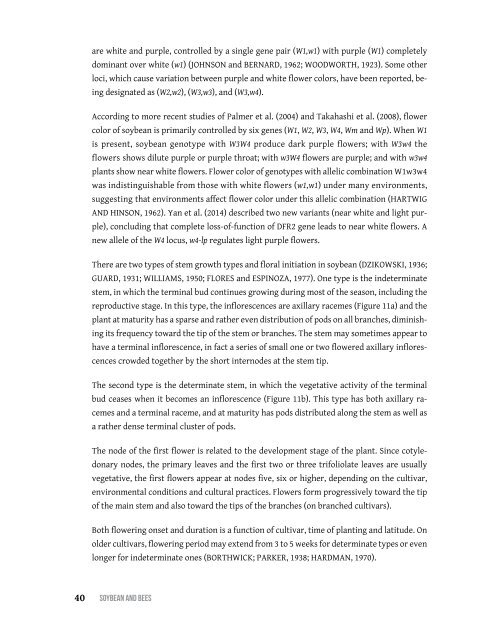Soybean and Bees
You also want an ePaper? Increase the reach of your titles
YUMPU automatically turns print PDFs into web optimized ePapers that Google loves.
are white <strong>and</strong> purple, controlled by a single gene pair (W1,w1) with purple (W1) completely<br />
dominant over white (w1) (Johnson <strong>and</strong> Bernard, 1962; Woodworth, 1923). Some other<br />
loci, which cause variation between purple <strong>and</strong> white flower colors, have been reported, being<br />
designated as (W2,w2), (W3,w3), <strong>and</strong> (W3,w4).<br />
According to more recent studies of Palmer et al. (2004) <strong>and</strong> Takahashi et al. (2008), flower<br />
color of soybean is primarily controlled by six genes (W1, W2, W3, W4, Wm <strong>and</strong> Wp). When W1<br />
is present, soybean genotype with W3W4 produce dark purple flowers; with W3w4 the<br />
flowers shows dilute purple or purple throat; with w3W4 flowers are purple; <strong>and</strong> with w3w4<br />
plants show near white flowers. Flower color of genotypes with allelic combination W1w3w4<br />
was indistinguishable from those with white flowers (w1,w1) under many environments,<br />
suggesting that environments affect flower color under this allelic combination (Hartwig<br />
<strong>and</strong> Hinson, 1962). Yan et al. (2014) described two new variants (near white <strong>and</strong> light purple),<br />
concluding that complete loss-of-function of DFR2 gene leads to near white flowers. A<br />
new allele of the W4 locus, w4-lp regulates light purple flowers.<br />
There are two types of stem growth types <strong>and</strong> floral initiation in soybean (Dzikowski, 1936;<br />
Guard, 1931; Williams, 1950; FLORES <strong>and</strong> ESPINOZA, 1977). One type is the indeterminate<br />
stem, in which the terminal bud continues growing during most of the season, including the<br />
reproductive stage. In this type, the inflorescences are axillary racemes (Figure 11a) <strong>and</strong> the<br />
plant at maturity has a sparse <strong>and</strong> rather even distribution of pods on all branches, diminishing<br />
its frequency toward the tip of the stem or branches. The stem may sometimes appear to<br />
have a terminal inflorescence, in fact a series of small one or two flowered axillary inflorescences<br />
crowded together by the short internodes at the stem tip.<br />
The second type is the determinate stem, in which the vegetative activity of the terminal<br />
bud ceases when it becomes an inflorescence (Figure 11b). This type has both axillary racemes<br />
<strong>and</strong> a terminal raceme, <strong>and</strong> at maturity has pods distributed along the stem as well as<br />
a rather dense terminal cluster of pods.<br />
The node of the first flower is related to the development stage of the plant. Since cotyledonary<br />
nodes, the primary leaves <strong>and</strong> the first two or three trifoliolate leaves are usually<br />
vegetative, the first flowers appear at nodes five, six or higher, depending on the cultivar,<br />
environmental conditions <strong>and</strong> cultural practices. Flowers form progressively toward the tip<br />
of the main stem <strong>and</strong> also toward the tips of the branches (on branched cultivars).<br />
Both flowering onset <strong>and</strong> duration is a function of cultivar, time of planting <strong>and</strong> latitude. On<br />
older cultivars, flowering period may extend from 3 to 5 weeks for determinate types or even<br />
longer for indeterminate ones (Borthwick; Parker, 1938; Hardman, 1970).<br />
40 SoybeAn <strong>and</strong> bees


